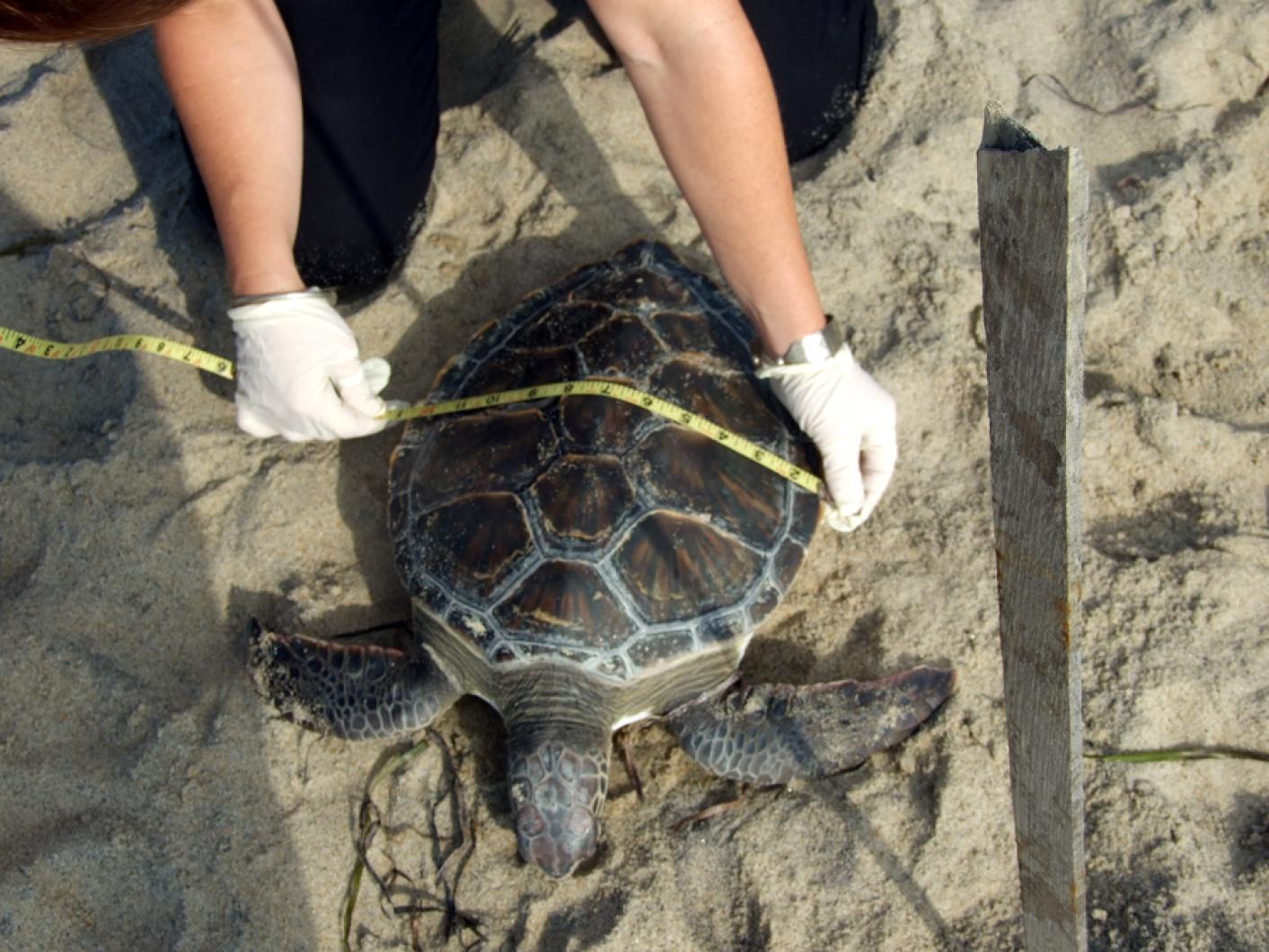Weathermen are not the only ones confused by this year’s unseasonably warm winter weather. Off the Cape and Islands, this winter more than 100 sea turtles, tempted to linger in the balmy waters, have met a cold and sandy end.
“This year I’ve seen more turtle strandings than I’ve ever seen in my 12 years here,” Felix Neck Wildlife Sanctuary director Suzan Bellincampi said on Thursday.
Last year there were zero reported strandings on the Vineyard; Ms. Bellincampi said one or two per year is typical. More than half a dozen turtles have washed ashore this winter and one of those, a Kemp’s Ridley turtle (the most endangered sea turtle in the world) had the unhappy honor of being the first stranding of the year in Massachusetts. That turtle, found at Sengekontacket on Oct. 30 in a state of cold-induced torpor known as cold-stun, was transported to the New England Aquarium’s sea turtle rescue facility in Quincy where caretakers have come to know him as Jack (short for Jack-o-Lantern). If Jack completes his rehabilitation, he will be the only Vineyard survivor this season.
“There’s one in pretty bad shape in Katama right now, there’s one rotting on Stonewall Beach, there were two green turtles on Chappy this year and two leatherbacks,” Ms. Bellincampi said, recounting the year’s roster of dead marine reptiles.
It is a trend that has been seen around the Cape and Islands, where the overall number of strandings are down but turtle mortality is up.
“Normally, of the turtles that are found, about half are alive,” New England Aquarium spokesman Tony LaCasse said yesterday. “This year only about a third were found alive. The animals that came in were much more sick than the animals you would normally see and the reason is that they were emaciated, which makes their immune system more vulnerable to pathogens.”
Mr. LaCasse suspects this fall and winter’s unusually warm weather and water temperatures are to blame for the starving turtles. Last year by the first week of December the aquarium had recorded 108 turtle strandings. This year by the same time it had recorded only eight. But after that, Mr. LaCasse said, the aquarium saw a steady three-to-four strandings per day. While the warmer temperatures might have allowed some turtles extra time to navigate out of the treacherous geography of Cape Cod Bay — which can act as a bucket for turtles migrating south — for others it has meant a dangerous, energy-sapping sojourn in New England.
“The season started very late,” said Mr. LaCasse. “There were prolonged warmer temperatures but it was still cold, so turtles were exposed to prolonged cool water temperatures a month longer than usual. What that meant was that they really used up the available body fat that they would normally store on board.”
He said the delay might explain the higher mortality on the Vineyard, where turtles depleted of energy reserves and slowed by illness had little chance of making it back to the Caribbean.
“I think what might have happened is, if we had turtles that were in Cape Cod Bay or in shallow waters anywhere around the Cape they began their migration later because of the warmer water temperature, but then when they got out into the open ocean, the water temperature was much cooler.”
Turtles are cold-blooded and depend on the external temperature of their environment for energy. Ms. Bellincampi said once the water temperature drops below 50 degrees, it can be a death sentence for the migrating turtles.
“Their body processes slow down, they lose the ability to swim, basically they’re just going with the flow,” she said.
But Ms. Bellincampi warned beachgoers not to assume that a seemingly inanimate turtle is dead. At the New England Aquarium, veterinarians have nursed animals with near-freezing internal temperatures, and managing only a lone heartbeat per minute, back to health.
“If it’s not decaying, it’s hard to tell if it’s dead or it’s just cold-stunned,” said Ms. Bellincampi. “If you find a turtle you should call the New England Aquarium or Mass Audubon.”
About 90 per cent of the turtles found stranded in the area are Kemp’s Ridley sea turtles, a critically endangered species that hatches at the Mexico-Texas border, measuring only the size of a silver dollar. The animals were driven nearly to extinction at mid-century by turtle processing plants that sprang up along the Gulf coast (the industry catered to, among other things, an appetite in Mexico for turtle eggs at traditional Easter festivals). But why do the tiny native Texans make the unimaginable trek to New England?
“In the marine world, migrations are all about food and sex,” said Mr. LaCasse. “We take it for granted that in the area around Cape Cod we have one of the most rich marine environments in the world.”
Turtles are also especially vulnerable to fallout from the Gulf oil spill. Large swaths of sargassum seaweed, favored by juvenile Kemp’s Ridley turtles, were vaporized in the days following the Deep Horizon blowout, and scientists expect the next few years will be critical in evaluating the effect on the species.
But Mr. LaCasse said that at least for Jack the prognosis is promising. Coming to the aquarium at a gaunt 4.8 pounds, with puny legs indicative of an animal that has exhausted its fat reserves, Jack currently weighs in at a plump seven pounds and is merrily swimming around his tank, still nursing a shoulder injury. Mr. LaCasse said if Jack is up to it, he will be released off the coast of Georgia in a month or two.
Anyone who comes across a stranded turtle should call the New England Aquarium’s 24-hour marine animal rescue hotline, at 617-973-5247, or Mass Audubon’s stranding hotline at 508-349-2615.







Comments
Comment policy »